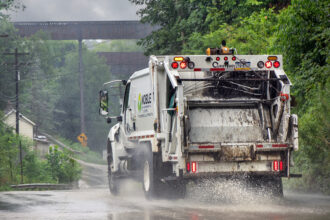A climate study released during one of the hottest summers on record predicts a 125-degree “extreme heat belt” will stretch across a quarter of the country by 2053.
Within the next 30 years, 107 million people—mostly in the central U.S.—are expected to experience temperatures exceeding 125 degrees, a threshold that the National Weather Service categorizes as “Extreme Danger.” That’s 13 times more than the current population experiencing extreme heat.
The hottest cities, according to the study, will be Kansas City, Missouri.; St. Louis; Memphis, Tennessee; Tulsa, Oklahoma; and Chicago.
“This is… really off the charts of the scales that we’ve developed to measure these kinds of things,” said Bradley Wilson, the director of research and development at First Street Foundation, the New York-based climate research nonprofit that developed the model.
Temperatures are expected to increase by 2.5 degrees over the next three decades. Warmer air retains water, creating more humid conditions and compounding heat indexes.
The Intergovernmental Panel on Climate Change has found that human activity, in particular fossil fuel emissions, has warmed the climate at an unprecedented rate in at least the last 2,000 years.

The peer-reviewed study is the foundation’s sixth national risk assessment and uses publicly available datasets in conjunction with existing climate research and heat modeling.
Extreme heat is most dangerous in waves, impacting health, energy costs and infrastructure. Long-lasting heat poses the greatest health risks, especially for vulnerable populations like children and the elderly.
The probability of at least three consecutive local hot days—the temperature an area could expect to see on the hottest seven days of the year—is expected to increase significantly across the country over the next three decades.
The study finds that, on average, the number of extremely hot days will more than double in that same period.
In Kansas, for example, the temperature soared above 98 degrees for seven days this year. By 2053, Kansans can expect 20 days at that temperature.
“We need to be prepared for the inevitable,” said Matthew Eby, founder and CEO of First Street Foundation. “A quarter of the country will soon fall inside the extreme heat belt, with temperatures exceeding 125 degrees Fahrenheit, and the results will be dire.”
Young children, older adults, people with chronic medical conditions, people who are low-income, athletes and outdoor workers are most vulnerable to extreme heat, according to the Centers for Disease Control. The agency reports an average of more than 67,000 emergency department visits due to heat annually.
Jared Opsal, executive director of Missouri Coalition for the Environment, a nonprofit advocacy group, hopes the report draws attention to what could be a public health crisis.
“I think that was hopefully a little bit of a wake up call for a lot of people who thought that this was something that wasn’t that big of a deal,” Opsal said.
Racially segregated communities contribute to disparities in heat exposure. A 2021 study found that the average person of color lives in a census tract with higher surface urban heat island intensity than white people in almost every city in the nation. There was a similar pattern among low-income people.
This story is funded by readers like you.
Our nonprofit newsroom provides award-winning climate coverage free of charge and advertising. We rely on donations from readers like you to keep going. Please donate now to support our work.
Donate NowDuffy-Marie Arnoult, Southeastern climate justice organizer for the Climate Reality Project, said it’s important for this data to be accessible so people can assess their risk and prepare.
“As a society, we need to be taking this seriously and working together to protect our most vulnerable populations,” said Arnoult.
First Street’s Risk Factor search tool calculates risk for flooding, fire and heat for any property in the contiguous U.S.
This story is a product of the Mississippi River Basin Ag & Water Desk, an editorially independent reporting network based at the University of Missouri School of Journalism in partnership with Report For America and funded by the Walton Family Foundation.
About This Story
Perhaps you noticed: This story, like all the news we publish, is free to read. That’s because Inside Climate News is a 501c3 nonprofit organization. We do not charge a subscription fee, lock our news behind a paywall, or clutter our website with ads. We make our news on climate and the environment freely available to you and anyone who wants it.
That’s not all. We also share our news for free with scores of other media organizations around the country. Many of them can’t afford to do environmental journalism of their own. We’ve built bureaus from coast to coast to report local stories, collaborate with local newsrooms and co-publish articles so that this vital work is shared as widely as possible.
Two of us launched ICN in 2007. Six years later we earned a Pulitzer Prize for National Reporting, and now we run the oldest and largest dedicated climate newsroom in the nation. We tell the story in all its complexity. We hold polluters accountable. We expose environmental injustice. We debunk misinformation. We scrutinize solutions and inspire action.
Donations from readers like you fund every aspect of what we do. If you don’t already, will you support our ongoing work, our reporting on the biggest crisis facing our planet, and help us reach even more readers in more places?
Please take a moment to make a tax-deductible donation. Every one of them makes a difference.
Thank you,











